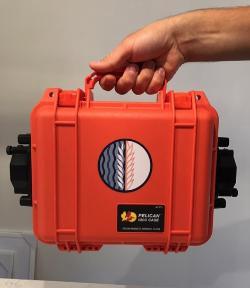March 23, 2018
 For senior Environmental Science major Becky Thielman, hydrology field research presented more challenges than simply dealing with wet and muddy streams and rivers: the pumps geologists used to measure stream flow were too fragile or too expensive to work effectively in the field.
For senior Environmental Science major Becky Thielman, hydrology field research presented more challenges than simply dealing with wet and muddy streams and rivers: the pumps geologists used to measure stream flow were too fragile or too expensive to work effectively in the field.
In response, Thielman designed a portable, low-cost alternative pump in collaboration with Visiting Assistant Professor of Geology and Environmental Science Dr. Sam Smidt. The two presented the design at the 2017 Geological Society of America Annual Meeting in Seattle, Washington.
“Most store-bought pumps are expensive, drain a lot of battery power, and are difficult to carry into the field when you’re setting up an experiment,” Thielman says. “I wanted to design something that was useful in a wide variety of field conditions.”
The existing pumps fall into two categories: expensive, lab-based designs that aren’t robust enough for field work or DIY pumps constructed by researchers. Both types require large and heavy batteries.
In contrast, Thielman’s pump design is lightweight, waterproof, user-controlled, and low-cost. She estimates that the total cost of her pump is $300, compared to the $1,000 price tag of other pumps on the market. Her design uses 12-volt batteries and is portable enough to easily use when testing stream discharge and water pollutants in the field. Her design can also be used as an inexpensive alternative for indoor lab studies focused on the variable flow rate of water, such as flood simulations.
Thielman has already used the pump for a project measuring the impact of surface water-groundwater interactions on stream health. Together with Smidt and junior Andrew Madsen, Thielman studied the ways that groundwater flow can impact watershed restoration projects and overall stream function. The group also presented their research at the 2017 GSA Annual Meeting.
Smidt describes Thielman as passionate and committed to the field of environmental hydrology.
“Becky has a genuine curiosity in environmental hydrology and is passionate about better understanding how ecosystems function. Her new pump design makes hydrology field research more practical and attainable for students at Wheaton and for geologists across the field,” Smidt says.
In addition to the research on surface water-groundwater interactions, Smidt plans to incorporate Thielman’s pump design into stream restoration projects with future Wheaton students.
Thielman also hopes to continue her research in hydrology and is already planning to make her pump design available online for other field researchers to recreate.
Wheaton College's Environmental Science program is a diverse combination of biology, geology, chemistry, physics, and mathematics to develop holistic solutions to pressing environmental challenges. Discover more information about the Environmental Science program here.